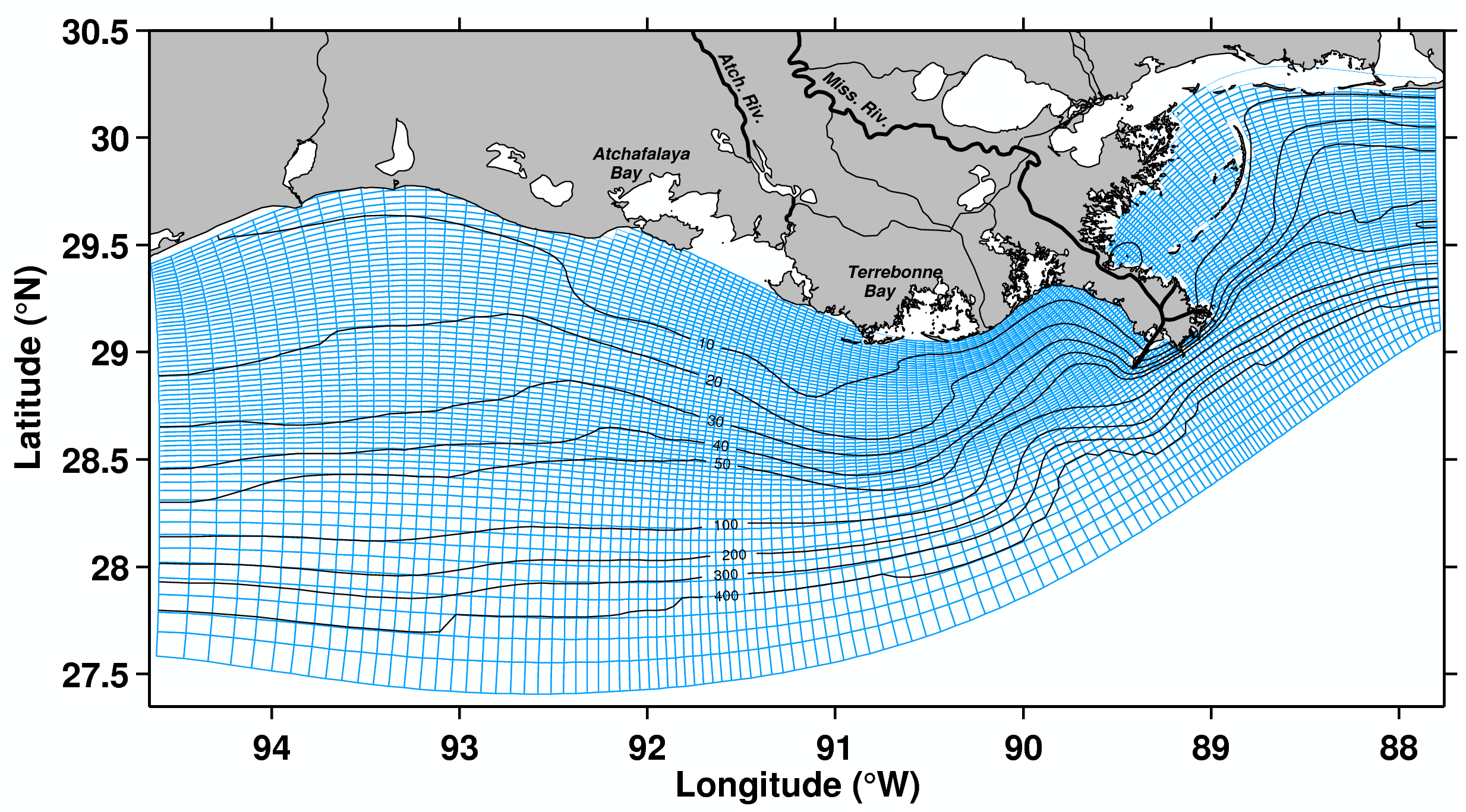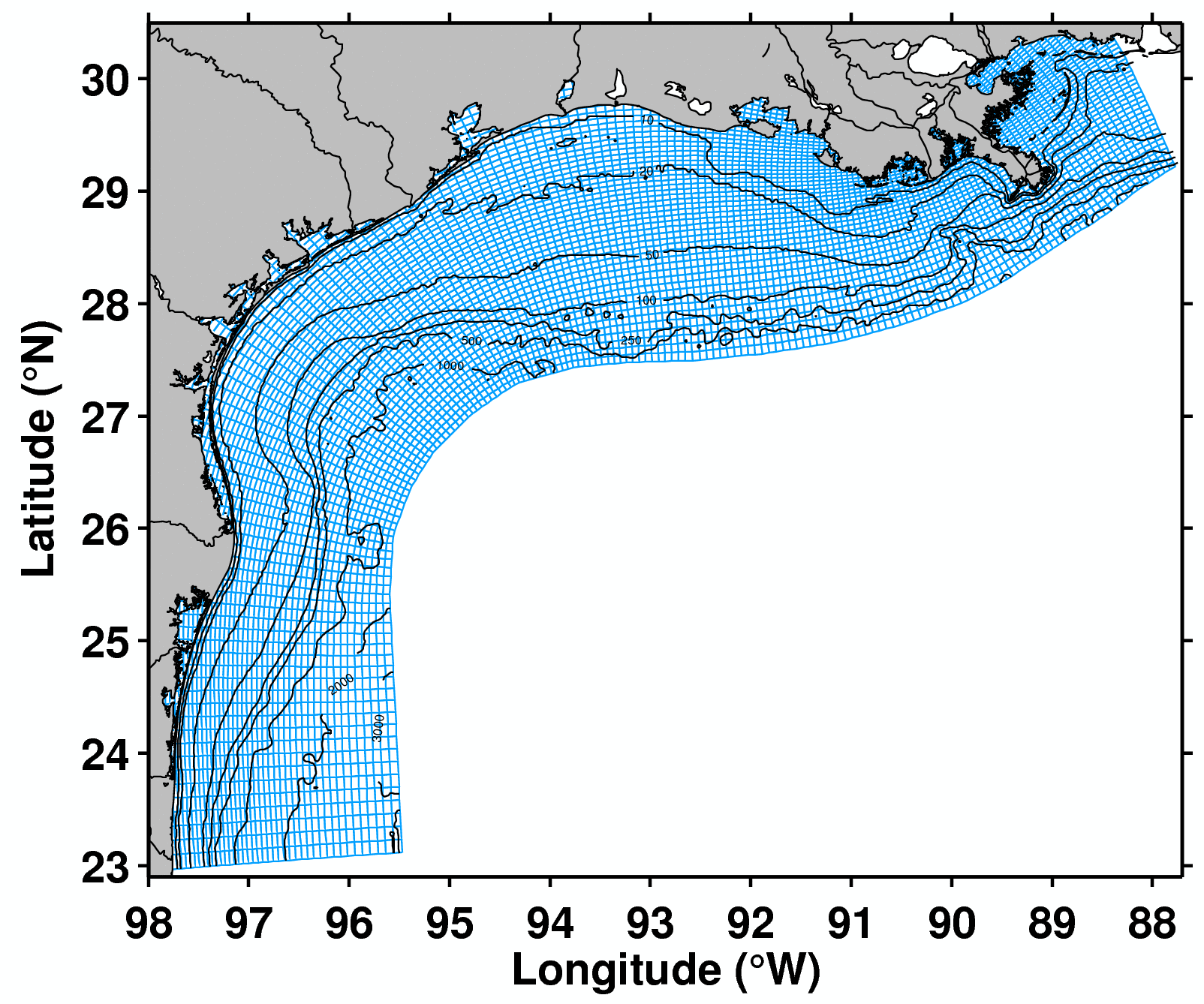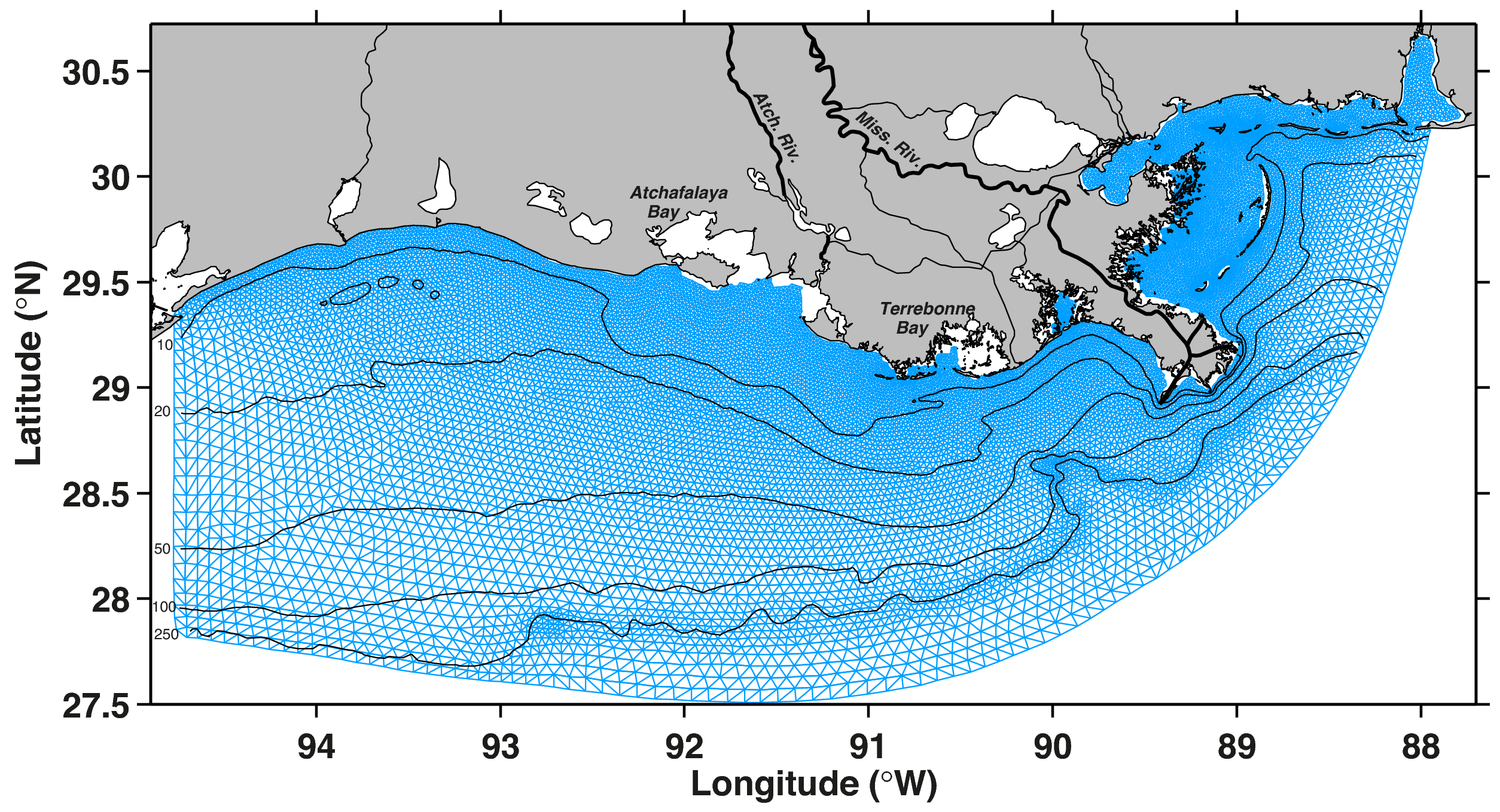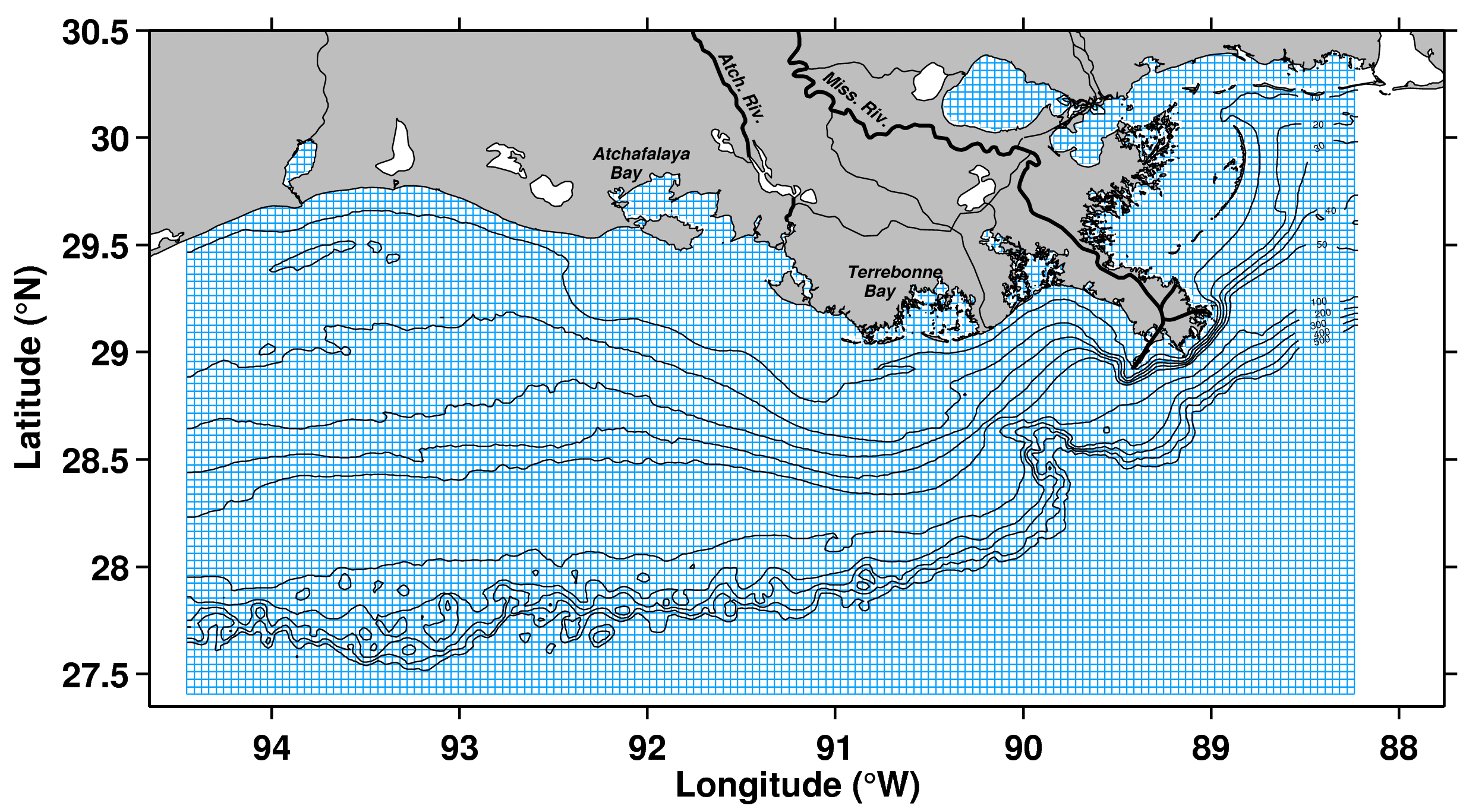Gulf of Mexico Hypoxia
Project Team
Project Lead: Katja Fennel, Dalhousie University, Halifax
CO-PIs: Dubravko Justic (LSU), Robert Hetland (TAMU), Dong S. Ko (NRL), John Lehrter (University of South Alabama, since 2017)
Other Project Personnel: Arnaud Laurent (Dalhousie), Lixia Wang (LSU), Daijiro Kobashi (TAMU)
Students: Liuqian Yu (Dalhousie), Veronica Ruiz-Xomchuk (TAMU)
Federal Partners:
NOAA-CSDL: Frank Aikman, Jinagtao Xu
EPA: John Lehrter (until 2016), Mike Murrell
Project Overview and Results
The largest hypoxic area in U.S. coastal waters, averaging 15,000 km2, forms every summer over the Texas-Louisiana shelf in the northern Gulf of Mexico. The formation is due to decay of organic matter that is primarily derived from nutrient inputs from the Mississippi/Atchafalaya river system. Efforts are underway to reduce the extent of hypoxic conditions through nutrient management in the watershed; for example, the interagency Hypoxia Task Force is developing Action Plans with input from various stakeholders that set out targets for hypoxia reduction. In order to improve mechanistic understanding of hypoxia formation and to inform nutrient management decisions, several coupled circulation-hypoxia models are being developed for the Mississippi River outflow region.
This COMT project conducts an inter-comparison of these hypoxia models and uses scenario simulations to assess the impact of potential reductions in nutrient load and of climate change on hypoxia formation. Understanding how and why model predictions differ will ultimately lead to improved model formulations, improved hindcasts and forecasts, and improved mechanistic understanding. The study is focusing on identifying factors that influence the prediction of dissolved oxygen concentration both to improve our understanding of the controlling processes and to provide guidance on the eventual implementation of dissolved oxygen forecasts in NOAA’s Northern Gulf of Mexico Operational Forecast System (NGOFS).
Simulated surface salinity and bottom water oxygen concentration in 2015 in the small ROMS domain.
Simulated surface salinity and bottom water oxygen concentration in 2016 in the small ROMS domain.
Model Descriptions
The work within this project builds on three different models for the northern Gulf of Mexico (ROMS, FVCOM and NCOM). All models are based on a circulation model that is either operational at NOAA or the Navy (FVCOM and NCOM) or pseudo-operational, i.e. run perpetually by an academic partner (ROMS). All models include biogeochemical modules of differing complexity for hypoxia simulation.
ROMS
The Regional Ocean Modeling System (ROMS; http://myroms.org), a widely used community model with a large international user base, is being run in two configurations, a computationally efficient "small domain" (Fig. 1a) and a higher resolution, computationally more expensive "large domain" (Fig. 1b). The small-domain model was developed as part of the Mechanisms Controlling Hypoxia (MCH, Hetland and DiMarco, 2008, 2012) project and includes the shelf region most commonly affected by seasonal hypoxia. This model was coupled with the ROMS biogeochemical module (Fennel et al. 2006, 2011, 2013, Laurent et al. 2012) and has undergone detailed model evaluation and sensitivity analyses in the first phase of COMT (Fennel et al. 2013, Mattern et al. 2013). A quasi-operational version of the large-domian model is being run by Hetland at Texas A&M University to provide short-term forecasts. The hypoxia simulations with both, the small- and large-domain models, are carried out by Fennel and Laurent at Dalhouise University.
Hetland, R. D. and S. F. DiMarco, (2008) How does the character of oxygen demand control the structure of hypoxia on the Texas-Louisiana continental shelf? Journal of Marine Systems 70:49-62.
Hetland, R. D. and S. F. DiMarco (2012) Skill assessment of a hydrodynamic model of circulation over the Texas- Louisiana continental shelf, Ocean Modelling 43-44:64-76.

Figure 1a: Computationally efficient "small-domain" ROMS grid.

Figure 1b: High-resolution "large" ROMS grid. Only every 4th gridline is shown.
FVCOM
FVCOM is being run at Louisiana State University. The FVCOM implementation includes both a simple hypoxia model and a WASP model. These models are being run in research mode and include only hindcasts. The hypoxia model uses a simple oxygen parameterization (Yu et al. 2015) that includes air-sea gas exchange, water column respiration and sediment oxygen consumption.The Finite Volume Coastal Ocean Model (FVCOM) developed by Chen et al. (2003, 2006) utilizes an unstructured triangular grid, which allows more accurate representation of complex coastline and bathymetry than structured grid models like ROMS and NCOM. The FVCOM implementation used in this project (Figure 2) is being run at Louisiana State University and its implementation and biogeochemical module have been described in detail by Wang and Justic (2009) and Justic and Wang (2014). FVCOM is also being run at NOAA as part of the NOS Northern Gulf of Mexico Operational Forecast System (NGOFS). Since April 2012 NGOFS has been running operationally 4 times a day at NCEP to provide short-term forecasts of water levels, currents, salinity and temperature (see http://tidesandcurrents.noaa.gov/ofs/ngofs/ngofs.html).
Chen, C., Liu, H., Beardsley, R.C, (2003) An unstructured grid, finite-volume, three-dimensional, primitive equations ocean model: application to coastal ocean and estuaries, Journal of Atmospheric and Oceanic Technology 20: 159-186.
Chen, C., Beardsley, R.C., Cowles, G. (2006) An unstructured grid, finite-volume coastal ocean model (FVCOM) system. Oceanography 19: 78-89.
Justic, D., and L. Wang (2014) Assessing temporal and spatial variability of hypoxia over the inner Louisiana–upper Texas shelf: Application of an unstructured-grid three-dimensional coupled hydrodynamic-water quality model, Continental Shelf Research., 72: 163–179.
Wang, L., Justic, D. (2009) A modeling study of the physical processes affecting the development of seasonal hypoxia over the inner Louisiana-Texas shelf: Circulation and stratification. Continental Shelf Research 29: 1464-1476.

Figure 2: Triangular FVCOM model grid.
NCOM
An implementation of the Navy Coastal Ocean Model (NCOM; Martin 2000) for the northern Gulf of Mexico shelf has been developed by Dong S. Ko at NRL. The model is nested within the Intra-Americas Sea Nowcast/Forecast System (IASNFS) model (Ko et al. 2003, 2008), which represents the Gulf of Mexico and Caribbean basins with 1/24th degree horizontal resolution (~ 6 km) and 41 hybrid vertical layers. The northern Gulf of Mexico shelf model uses a finer resolution (~2 km). In collaboration with EPA partners John Lehrter and Michael Murrell, IASNFS-LCS was coupled to the Gulf Ecology Model (Eldridge and Roelke 2010) and shown to reproduce the observed salinity, temperature, stratification and mean circulation (Lehrter et al., 2013).
Eldridge, P.M., and D.L. Roelke (2010), Origins and scales of hypoxia on the Louisiana shelf: importance of seasonal plankton dynamics and river nutrients and discharge, Ecological Modelling 221:1028-1042.
Ko, D.S., R.H. Preller, and P.J. Martin (2003), An experimental real-time Intra-Americas Sea Ocean Nowcast/Forecast System for coastal prediction, paper presented at AMS 5th Conference on Coastal Atmospheric and Oceanic Prediction and Processes, Seattle, Washington.
Ko, D.S., P.J. Martin, C.D. Rowley, and R.H. Preller (2008), A real-time coastal ocean prediction experiment for MREA04, Journal of Marine Systems, 4, 17-28.
Lehrter, J. C., D. S. Ko, M. C. Murrell, J. D. Hagy, B. A. Schaeffer, R. M. Greene, R. W. Gould, and B. Penta (2013), Nutrient distributions, trans- ports, and budgets on the inner margin of a river-dominated continental shelf, Journal of Geophysical Research Oceans, 118:, 4822–4838.
Martin, P.J. (2000), Description of the navy coastal ocean model version 1.0, NRL/FR/7322--00-9962, Naval Research Laboratory, Stennis Space Center, Mississippi.

Figure 3: NCOM grid for northern Gulf of Mexico model. Only every 4th gridline is shown.
Sub-Project Descriptions/Data
Model Intercomparisons
We conducted a physical model intercomparison where all three circulation models (ROMS, FVCOM and NCOM) use the same simple hypoxia model (Yu et al. 2015), which only includes air-sea gas exchange, water column respiration and sediment oxygen consumption. The most important results from this analysis are: (1) the importance of bottom water temperature and the thickness of the bottom boundary layer for hypoxia prediction, (2) the fact that hypoxic layer thickness coincides with bottom boundary layer thickness in all models, (3) a demonstration that model errors can compensate for each other such that two models can generate the same hypoxic area, but for different reasons, (4) that hypoxic volume should be considered in addition to hypoxic area, and (5) that the proper treatment of the vertical attenuation of shortwave radiation in the heat equation is extremely important (Fennel et al. 2016). A biogeochemical model inter-comparison is ongoing.
Collaborators: Katja Fennel (Dalhousie), Arnaud Laurent (Dalhousie), Dubravko Justić (LSU), Lixia Wang (LSU), Liuqian Yu (Dalhousie), Robert Hetland (Texas A & M University), Dong S. Ko (NRL), John Lehrter (EPA/USA), Mike Murrell (EPA)
Publications:
Datasets:
Nutrient Reduction and Climate Change Scenarios
Scenario-based simulations were conducted to assess the potential impacts of nutrient management decisions in the Mississippi River Basin and future climate conditions on hypoxia in the northern Gulf. Results will inform the interagency Hypoxia Task Force’s efforts to devise near-term and long-term nutrient management strategies.
We have quantified the effects of differential reductions in river N and P loads on hypoxic extent (Fennel and Laurent 2018). An assessment of the effects of N versus P reductions is important because, thus far, nutrient management efforts have focused on N, yet P is known to limit primary production in spring and early summer (Laurent and Fennel 2017). Our results indicate that while N is the ‘ultimate’ limiting nutrient to primary production, temporary P limitation in spring plays a large role in determining areal hypoxic extent and cumulative hypoxic exposure. Reductions in either river N or P load would decrease hypoxic extent but combined reductions of N and P would have the greatest effect (Fennel and Laurent 2018).
Climate change scenario simulations show that future warming will expand the hypoxic zone and make hypoxia more severe (Lehrter et al. 2017, Laurent et al. 2018).
Collaborators: Katja Fennel (Dalhousie), Arnaud Laurent (Dalhousie), Dong S. Ko (NRL), John Lehrter (EPA/USA)
Publications:
Laurent, A., Fennel, K., Modeling river-induced phosphorus limitation in the context of coastal hypoxia, In: Modeling Coastal Hypoxia: Numerical Simulations of Patterns, Controls and Effects of Dissolved Oxygen Dynamics, Justic, D., Rose, K.A., Hetland, R.D., Fennel, K., (eds.), p. 149-171, Springer, 2017
Lehrter, J.C., Ko, D.S., Lowe, L.L., Penta, B., Predicted effects of climate change on northern Gulf of Mexico hypoxia, In: Modeling Coastal Hypoxia: Numerical Simulations of Patterns, Controls and Effects of Dissolved Oxygen Dynamics, Justic, D., Rose, K.A., Hetland, R.D., Fennel, K., (eds.), p. 173-214, Springer, 2017
Datasets:
Retrospective Hypoxia Analyses
Since the fall of 2016 we have carried out a two-model hindcast of the preceding hypoxic season. Simulations were carried out with ROMS and FVCOM, results were compared against available observations, animations were produced, and products like the cumulative hypoxic area were derived. All results were made available to the Hypoxia Taskforce for broad dissemination.
Collaborators: Katja Fennel (Dalhousie), Arnaud Laurent (Dalhousie), Dubravko Justić (LSU), Lixia Wang (LSU)
Datasets:
